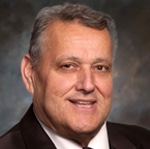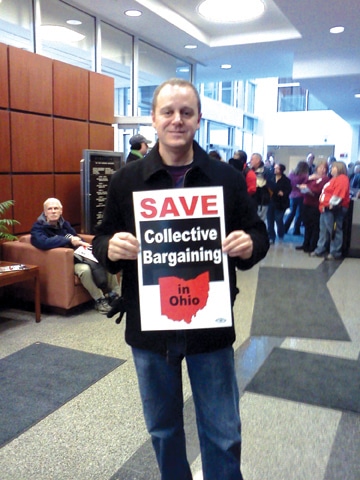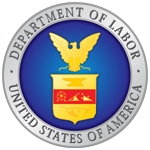
The department’s Occupational Safety and Health Administration will announce the plan on Thursday as part of a proposed rule that would dramatically change the way companies file safety records, according to a person familiar with the proposal.
Read the complete story at the Journal Review.
Author: matrixsuperadmin
In September, delegates from both the SMART Transportation and Sheet Metal Divisions stood together united as one on the floor of the AFL-CIO convention. SMART’s message to our brothers and sisters in the labor movement was simple. We demanded that organized labor, as a whole, hold national, state and local elected leaders accountable for their actions – regardless of their party label and irrespective of any promises they may have made in the past.
The last six years have been difficult for working people. The Great Recession, caused through no fault of our own, was devastating to millions of working families. Making the pill even more bitter and harder to swallow was the fact that when working people asked for a hand up, we were ignored and our hard-earned tax money was diverted to bail out the same Wall Street banks and CEOs who created the mess in the first place.
For those who work in the private sector, whether in construction or transit, the harm done was further exacerbated when we asked to be treated in the same manner as companies like Wal-Mart, who received a one-year waiver from the rules that will be set for administering the Affordable Care Act.
SMART, as well as the rest of the labor movement, supports the goal of better access to quality, affordable health care for all Americans. However, many union health care funds are multi-employer plans, designed to pool the resources of union employers in order to reach the best possible deal on health care benefits for members. Rather than treat these plans in the same way larger employers like Wal-Mart are treated, they were instead pushed out of the exchanges and, in effect, will be undermined by the government subsidies available through the health care exchanges. Amazingly, Obamacare will be undercutting and destroying the very health care plans of its staunchest supporters in order to cut the health care costs of America’s largest corporations. That is outrageous, and another example of why it is important, regardless of who is in office, to remain vigilant – to vote based on issues and not party identification or empty promises.
Let me point to a specific action that illustrates the power of unified action in fighting for workers’ rights on the political front. Adren Crawford, the SMART Transportation Division’s Tennessee State Legislative Director, worked with the SMART Sheet Metal Division Locals 4, 5, 177 and 555 to fight attacks on workers’ compensation and prevailing wage laws in that state. SMART’s transportation members now have a stronger legislative offensive to protect transportation members when they are being transported from point to point at work in that state, as well as support in securing prevailing wage rates for sheet metal construction workers. We see, in this joint effort, how the legislative experience and connections on the transportation side of our union combines with the sheet metal membership strength to show the benefits of the merger.
A similar experience is occurring in Illinois, where the SMART Transportation Division’s state legislative board met with Sheet Metal Local 73 to begin planning joint activities in that state. In Southern California, local unions have come together and worked on joint organizing projects, such as at Bombardier Inc., which manufactures and services passenger rail equipment and serves as an integral piece of the rail transportation pipeline in North America. Earlier this summer, workers at Bombardier overwhelmingly chose to join SMART and we anticipate future organizing efforts at other locations to prove just as successful.
When I hear about these joint efforts, it gives me a sense that the levels of trust and cooperation have increased. To some extent, credit has to be given to the transparency of our operations. We have in place a system of checks and balances that ensure, starting with the General Executive Council, SMART is financially viable. Leaders from both the Transportation and Sheet Metal Divisions serve on that council and we share information to make sure our decisions represent the best interests of our members. In this way, we are accountable for our actions and answerable to the membership.
I want you to remember that this is YOUR union. My job is to work for you. I only ask that you become more involved on the “union side” of being a member. Our union is only as strong as we make it and the stronger it becomes, the more it benefits you and your family. I encourage everyone to take part in their union meetings, campaigns and events. We need you to join SMART’s Facebook pages, either at www.facebook.com/smartunion or by searching “SMART Transportation” in the Facebook search bar. You can also join the SMART Action Team to stay abreast of action alerts and other news items via www.smartaction.org.
SMART is working for you and building a stronger and brighter future for this organization and for our families.
Fraternally,
Joseph J. Nigro,
SMART General President
With 85 percent of eligible ballots returned, SMART Transportation Division conductors and assistant conductors on the Northern Illinois Regional Commuter Railroad Corp. (known as Metra) have approved a seven-year mediation agreement governing wages and working conditions, through calendar year 2018.
Included in the agreement are lump-sum signing bonuses, general wage increases each year of the contract, retroactive pay, enhanced deferred compensation, conductor certification pay for assignments paying the conductor rate of pay, a new training/qualifying understanding, a modified short term disability plan and seniority retention provisions.
SMART Transportation Division Vice President John E. Lesniewski and SMART International Representative John Babler, who assisted with negotiations, commended GO 721 General Chairperson Barry Abbott for his “persistent and systematic attentiveness to the needs of our membership on his property.” In turn, Abbott offered his thanks to Lesniewski and Babler for “bringing a wealth of experience and an enduring commitment to the bargaining table. This was truly a team effort,” he said.
Metra is the commuter rail division of the Illinois Regional Transportation Authority. The system serves Chicago and its metropolitan area through 241 stations on 11 different rail lines.
In a rare display of bipartisan functionality on Capitol Hill, the House Transportation & Infrastructure Committee Panel on 21st Century Freight Transportation has released its final report on the current state of freight transportation in the U.S. and its recommendations for freight transportation improvements to strengthen the national economy.
To “safely and efficiently meet the needs of freight movement in the 21st century,” the Freight Panel recommends that Congress should:
Read the complete story at Railway Age.

The railroad reported revenues of $3 billion for the third quarter that resulted from higher volumes and pricing gains in merchandise and intermodal. CSX reports an operating income of $854 million and an operating ratio of 71.5 percent.
“CSX now expects full-year 2013 earnings-per-share to be slightly up from 2012 levels. In addition, the company remains on target to achieve its goal of sustaining a high-60s operating ratio by 2015, while remaining focused on attaining a mid-60s operating ratio longer-term,” CSX said.
Operating ratio is a railroad’s operating expenses expressed as a percentage of operating revenue, and is considered by economists to be the basic measure of carrier profitability. The lower the operating ratio, the more efficient the railroad.
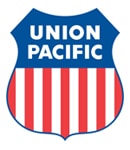
Operating revenue for the railroad had a four percent increase to $5.6 billion over last year’s $5.3 billion. Union Pacific recorded an operating ratio of 64.8 percent, a best-ever quarterly record. Operating income totaled $1.96 billion, up 10 percent over last year for the same quarter.
“Union Pacific achieved all-time record financial results this quarter,” said Jack Koraleski, Union Pacific chief executive officer. “Despite the challenges of lower coal and grain volumes, in addition to disruptions caused by the Colorado flooding, we managed our network efficiently and continued to benefit from the strength of our diverse franchise. When combined with real core pricing and productivity gains, we more than offset flat volumes to generate a new, best-ever quarterly Operating Ratio of 64.8 percent.
“As we move through the fourth quarter, we continue to monitor the economic landscape. Supported by our diverse franchise, we remain agile and well positioned for economic recovery,” Koraleski added. “We’ll continue to focus on running a safe, efficient, and reliable network that generates greater value for both our customers and shareholders going forward.”
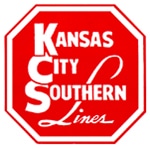
The railroad reports an operating income up 11 percent at $200 million and an operating ratio of 67.8 percent for the third quarter. Operating ratio improved over 2012 figures by 0.9 points.
Diluted earnings-per-share was up at $1.07 while KCS reported $0.82 for the same quarter last year. Adjusted diluted earnings-per-share showed an increase of 16 percent, coming in at $1.10 for the third quarter of 2013. Diluted earnings-per-share for the third quarter of 2012 were at $0.95.
“Looking ahead, we expect a strong end to the year benefited by growth in export grain shipments. We also look forward to long-term improvement in our operating ratio as we move forward with our plan to increase the percentage of equipment we own versus lease,” David L. Starling said, president and chief executive officer at KCS.

The railroad reports a one-time expense of C$19 million (C$0.05 per diluted share) resulting from an income tax adjustment. Excluding this expense, earnings per share (EPS) saw an increase of 13 percent to C$1.72 from 2012’s EPS of C$1.52.
Revenues saw an eight percent increase to a quarterly record of C$2,698 million, which was driven by a four percent increase in revenue ton-miles, and a three percent increase in car loadings.
Operating income for the railroad also increased 10 percent to C$1,084 million and operating ratio also saw an improvement of 0.8 of a point to 59.8 percent.
“CN’s agenda of Operational and Service Excellence delivered outstanding financial results for the quarter. All our key operating metrics improved, service levels remained solid and we reached new levels of safety in our train operations,” President and Chief Executive Officer Claude Mongeau said. “With continued focus on supply chain collaboration and solid execution, the CN team is determined to grow its business safely and efficiently at a pace faster than the overall economy and to meet its full-year 2013 financial outlook.”

The company reports adjusted earnings per share (EPS) of C$1.88, a growth of 45 percent over the third quarter of 2012. Total revenues saw an increase of six percent to C$1.5 billion, while operating expenses saw a decrease of six percent down to C$1 billion.
Chief Executive Officer E. Hunter Harrison said, “By all standards, this was an outstanding quarter. The company’s focus on service execution while controlling costs is a testament to our team of dedicated, hardworking railroaders. We enter the fourth quarter with momentum and are well positioned for what I believe will be a record 2013.”
Norfolk Southern publicized its third quarter net income of $482 million, a 20 percent increase over the third quarter of 2012 today. The same quarter last year only saw a net income of $402 million. Net income was also up $17 million over the second quarter of this year.
Diluted earnings per share were at $1.53, up 23 percent over last year’s $1.24. Operating revenues for the railway were at $2.8 billion, five percent higher than the same quarter of 2012. Shipment volumes saw an increase of four percent.
Income garnered from railway operations was $849 million, up 16 percent. Operating ratio improved by three percentage points to 6
9.9 percent.
CEO Wick Moorman said, “Norfolk Southern delivered strong results, led by growth in our chemicals, metals/construction, intermodal, and automotive businesses, combined with ongoing productivity improvements. Even in the face of continuing weakness in the coal markets, our focus on service efficiency and velocity allowed us to provide superior performance for our customers and excellent results for our shareholders.”
WASHINGTON – The Transportation Trades Department of the AFL-CIO joins the rest of the nation this week in thanking the men and women dedicated to transporting children to and from school during National School Bus Safety Week. In recognition of the challenges faced by school bus drivers, today TTD is announcing it will host a School Bus Summit on Dec. 2, 2013, in Washington, D.C., with its member unions.
“It is time to both thank school bus drivers for the indispensable role they play in making sure our kids are safe and secure, and also to address their everyday challenges,” said TTD President Edward Wytkind.
School buses remain the safest form of transportation for school children, carrying 25 million students to and from school every day on approximately 500,000 buses. TTD honors the drivers for their unyielding commitment to safety and dedication to their communities.
“The untold story is that school bus drivers are expected to fulfill their enormous responsibilities while too often driving overcrowded buses and without adequate support and training,” Wytkind said. “Meanwhile, unscrupulous private entities seek to outsource their jobs on the cheap and force them to work under often difficult conditions.”
To address many of these challenges, TTD will bring together union activists and drivers and federal regulators in the December summit. Participants will share ideas and strategies to address pressing concerns, including privatization of bus service, unmet training needs, overcrowded buses and burdensome employment requirements.
“The TTD School Bus Summit will focus on the men and women who work in this sector,” Wytkind added. “We cannot expect our nation’s school bus drivers to work in substandard conditions due to flawed policies and employers who cut all the wrong corners.”
More details on the summit will follow in November.

There are two ways to take the vaccine – by injection or nasally – and there are different types of vaccine options. The vaccine traditionally protects against three or four different kinds of flu viruses: two that are influenza A and one or two that are influenza B.
Several of the vaccines are egg-based which means they’re manufactured in eggs or with egg protein. Those who are sensitive to eggs should discuss with their doctor which type of flu shot they should get.
If you are in one of the following categories, you should get a flu shot:
- 50 years or older;
- At high risk of developing complications from the flu, such as pneumonia;
- Have asthma, diabetes or chronic lung disease or other conditions;
- Are a resident of a nursing home.
You can receive your vaccination at clinics, pharmacies, health departments or your doctor’s office. If your provider accepts Medicare, then Railroad Medicare should also be accepted. If they have any questions, they can call the Provider Contact at (888) 355-9165 from 8:30 a.m. to 4:30 p.m.
If you have questions about your coverage call the Railroad Medicare Beneficiary Contact Center at (800) 833-4455 between 8:30 a.m. and 7 p.m., EST, Monday through Friday or visit www.PalmettoGBA.com and click on “Railroad Beneficiaries” along the left side.

Some pilots make as little at $17,000 a year and so are forced to sleep in cheap “crash pads” or in “crew rooms” where there isn’t even a bed or decent place to lay their heads.
Click here to view a slideshow from ABC News of some of the uncomfortable and/or unsanitary places pilots and crew-members are forced to sleep due to lack of funding and the airlines’ refusal to pay for decent accommodations for its employees.
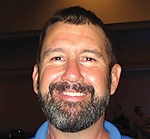
Armed with polling data obtained by SMART?Transportation Division?political consultant Dean Mitchell of DFM?Research, Colorado State Legislative Director Carl Smith and Assistant Legislative Director Charlie Skidmore Sept. 14 presented community leaders from Colorado, Kansas and New Mexico, convened in Pueblo, with data showing large support for funding of Amtrak’s Southwest Chief service.
“With the knowledge that state and local politicians from Kansas, Colorado and New Mexico would be attending this event, Kansas State Legislative Director Ty Dragoo and myself had discussions with Dean Mitchell at the Anaheim regional meeting about doing a survey to show the politicians from our respective states the support the public has for Amtrak, even in the most conservative districts,” Smith said.
The surveys were conducted in Colorado’s 4th District and Kansas’ 1st and 2nd Districts, home to traditionally conservative voters between September 3 and September 10. About 800 adults responded to the survey, 400 in Colorado and 200 in each of the Kansas districts polled.
The survey found that people had a favorable view of Amtrak and high speed rail, with 44 percent of people polled stating that passenger service should increase and 40 percent stating that it should remain the same. Only four percent of those polled stated that the service should be eliminated, while 12 percent were unsure of what should happen.
Seventy-one percent of those interviewed said they would support additional service in the cities of Denver and Kansas City.
Forty-five percent of those polled said that their state governments should provide some funding for Amtrak and 49 percent were in favor of keeping the current levels of government funding. Of the 45 percent that said their state should contribute to the funding of Amtrak, 83 percent stated that they supported their states providing up to one third of one percent of the state transportation budget to keep daily Amtrak service.
“The survey was well worth the expense and will be a valuable tool for the state directors of Kansas, Colorado and New Mexico to present to state legislatures and governors when discussing funding for Southwest Chief service,”?Smith said.
Smith also presented the findings to attendees at the Labor Initiative of the Colorado Democratic Party event held Sept. 18.
Click here to view all results from the survey.
In the face of an NBC News/Wall Street Journal poll showing 62 percent of Americans oppose revoking collective-bargaining rights for public employees, the Ohio Senate March 2 moved to repeal the core of those rights for Ohio state employees.
The New York Times reports the measure will clear the Ohio House of Representatives — having a sizeable Republican majority — and that Ohio Republican Gov. John Kasich will sign the bill.
The newspaper calls the action nothing less “than a near complete dismantling of public-worker protections that have been in place in Ohio since 1983.”
In a close vote, the Ohio Senate voted 17-16 in favor of passage — with six Republicans joining all Democrats in opposing the measure.
The bill outlaws strikes for any public employee, removes health care insurance from any form of bargaining, eliminates binding arbitration for law enforcement and firefighters, and establishes, for all Ohio public employees, fact-finding bodies to make recommendations that, if rejected, allow a school board, city council or legislature to impose its own last/best offer.
In other words, the employer gets to determine the outcome of negotiations.
The president of the Fraternal Order of Police told the Columbus Dispatch newspaper that the bill “ensures that no employer has any reason to bargain in good faith … because they get to dictate the terms at the end.”
UTU members — and many UTU International headquarters staff in North Olmsted, Ohio, who belong to the Office and Professional Employees International Union — joined thousands of union and non-union workers over the past two weeks demonstrating against the measure outside the Ohio legislature in Columbus.
While the NBC/Wall Street Journal poll also showed that a majority of Americans support public employees paying more for health care and retirement benefits, public-employee unions in Ohio and other states already have indicated a willingness to grant states concessions, belying allegations of those Republican-controlled state legislatures and their Republican governors that they want merely to balance state budgets.
Union busting clearly is the intent. Ohio Democrats say they will push for a voter-referendum to repeal the bill.
Somewhat troubling in the poll is that Americans’ perception of private-sector and public-sector labor unions is lukewarm — with just 38 percent of respondents indicating a “positive” or “somewhat positive” impression of both private-sector and public-sector unions; and an almost equal number having a “somewhat negative” or “very negative” impression of labor unions.
The assault on public-employee collective bargaining continues in Indiana and Wisconsin.
The New York Times reports that in Wisconsin, “a standoff over legislation that would cut collective bargaining rights for public employees intensified. Democrats in the state Senate, who left Wisconsin last month to prevent a vote from taking place, learned that the Republicans left behind were taking steps to start fining missing lawmakers $100 for each day they stay away.”
In Indiana, the Indianapolis Star newspaper reports that the standoff, where Democrats have left the state to block House Republicans from passing anti-union legislation, continues.
And in Arizona, where the legislature is considering 20 anti-union bills, the UTU’s State Legislative Director Greg Hynes spoke out after 59 Republican senators and house members signed onto a resolution supporting Wisconsin Gov. Scott Walker’s union-busting agenda. “It is essential to the democratic system [that] workers should always have a voice, and to take that away is not American,” Hynes told the media in Phoenix.
UTU HQ employee Carl Morgano at a pro-worker rally in Columbus, Ohio
